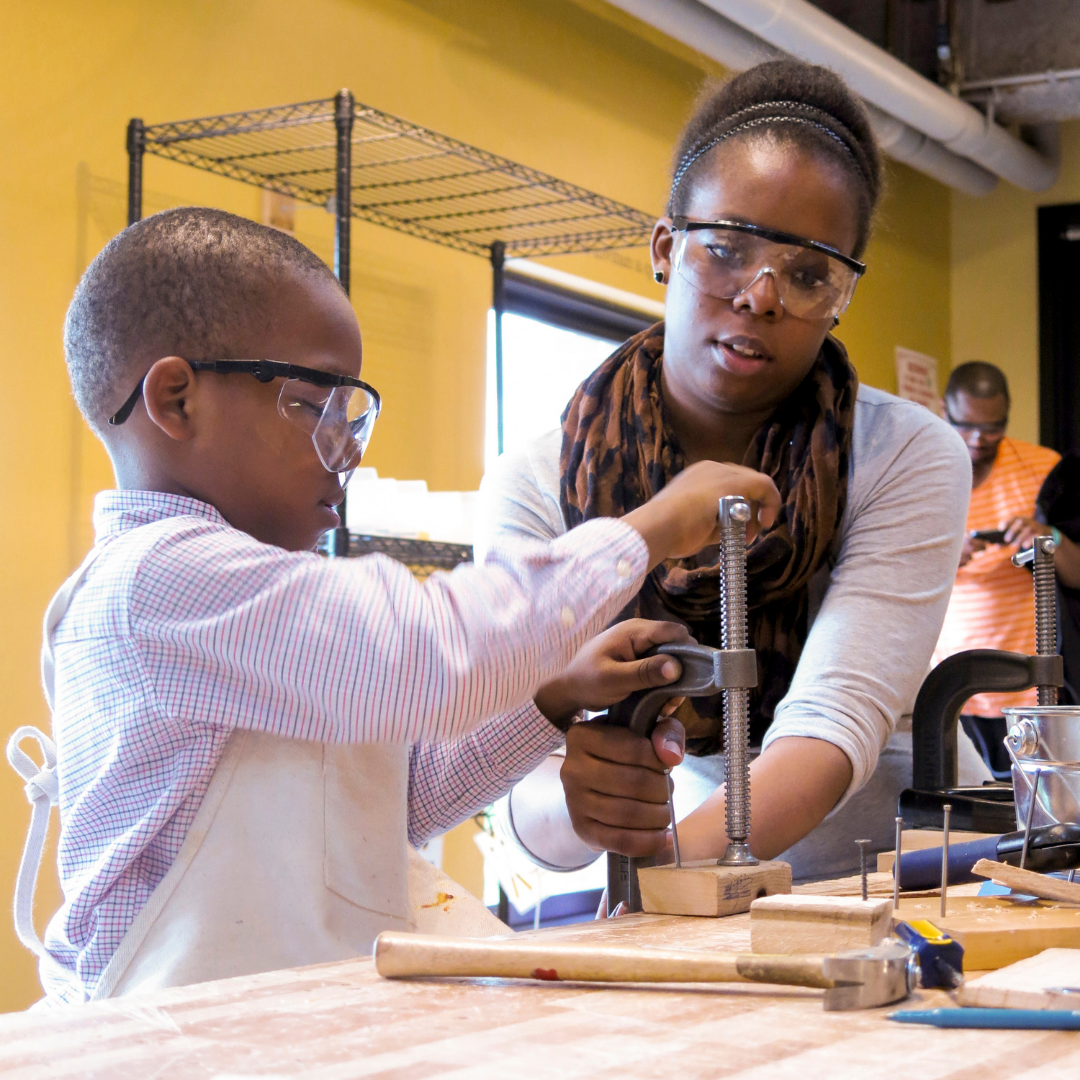Today’s Parenting Playbook post comes from Tsivia Cohen, Associate Vice President of Play & Learning Initiatives at Chicago Children’s Museum. Tsivia plays an important role in one of our most exciting projects: Tinkering and Learning Engineering Stories, our research project in partnership with the National Science Foundation, as well as Northwestern and Loyola Universities. This post outlines some of the biggest takeaways from this research.
“Experience isn’t quite enough! Experience not quite enough!
Processing is what it’s really all about...
Looking back’s worth a lot!”
Children like to be busy: they build, they climb, they pull stuff out of cabinets, they wrestle with the dog, they mix together things that were never meant to be mixed, they build a fort. So what happens to all this activity? What gets stored in memory and woven into children’s understanding of how the world works? How can we support the connection between children’s play and learning?
Part of our work at the museum has been to look at this question. Through research funded by the National Science Foundation, we’ve been working with our university partners at Northwestern and Loyola University Chicago to examine how encouraging children to talk about their experiences can impact the depth of what they learn and recall. When children reflect about what they’ve been doing—looking back and describing their experiences—they begin to process what happened and turn it into long-term learning. Our research findings continue to reinforce how important these reflective conversations are to children’s learning.
Here’s an example of what I’m referring to:
Parent: Why do you think our fort kept falling down?
Child : Because we didn't do the blankets right. But it was okay, ‘cause we found a way to do it in the end.
Parent: So what made it work better?
Child: I went and got some books to put on the blanket to keep it on the couch. But then, well, it still fell when you went inside.
Parent: Me? (laughing) What about me made the blanket come down?
Child: Well, you’re taller so your head pushed on it.
Parent: Oh dear. How did you figure out how to fix that?
Child: We got the bigger blanket out of the closet but it fell down anyway until I moved the chair closer to the couch.
Parent: How did that help?
Child: It made the fort less saggy so you could fit inside it.
Parent: I still had to duck to keep from hitting the roof.
Child: Yeah, you had to make yourself short so you didn’t knock off the roof.
Putting words to what they’ve been doing helps children make sense of their experiences. Every-day activities become both stickier—more memorable—and more portable, while enabling children to glean important concepts that will benefit their long-term learning. Reflecting also allows children to create some distance between themselves and the specifics of what happened. This is called “concreteness fading” and it’s important to how we take all the bits and bobs of our lives and build more abstract knowledge and concepts.
Supporting children’s reflections is one of the most powerful tools we as adults have to support children’s learning. Here are a few tips from the research:
1. Encourage children to tell the “story” of what happened.
Stories are a format that is familiar to children. When we encourage children to tell “the story” of what happened, we help them organize their experiences into a narrative. Stories include the element of time (What happened first? What came next?) as well as anticipation and hypothesis testing (What did you think would happen? What actually occurred?).
2. Listen and offer open-ended questions and prompts.
Our research team has noted how eager most children are to talk about their experiences. This is especially true of ones that include solving a problem or facing a challenge. Some prompts we’ve found to work: Tell me about what you made. How’d you figure that out?
3. Offer words for ideas and things.
As you listen to your child’s reflections, expand on what they’re saying, perhaps adding vocabulary. Young children need help putting experience into words. “I put it here and here” can be expanded into “You’ve been weaving. You wove the ribbon under and over the spokes of your bike wheel.” Tagging objects and actions with more specific words allows children to connect one experience to another.
4. Engage in experiences together.
When you share an activity with your child, you’re better able to deepen the experience and to support their reflections by sharing your own memories. In addition to reminding children of what occurred, you can help them link what happened to earlier experiences. “This makes me think of that day when…” Catherine Haden of Loyola University has shown that young children are better able to remember activities that were “jointly handled and jointly discussed.”
5. Preload the process of reflection.
Let your child know they’ll have a chance to talk about their experiences afterwards. Knowing that you’ll listen later, can spark children’s memory making even while they’re engaged in the activity. This is also a strategy for promoting more independent play--especially helpful now when children are separated from playmates.
6. Talk about activities involving movement.
Talking about physical activities such as climbing and throwing provides an opportunity for spatial learning. Our bodies are how we begin to understand measurement, directionality and orientation, and talking about these experiences allows children to process important concepts. Development of spatial intelligence is critical to children's lifelong math and science learning.
7. Save the evidence.
Whether it’s pictures you snap or the actual object that children make, having a physical record of what happened can make it easier to reflect. A study looking at families’ conversations after visiting the museum’s Tinkering Lab exhibit found that children who had their creations with them used more engineering and math vocabulary while they were reflecting. Photographs can also prompt richer reflections by reminding children of physical and emotional aspects of their experiences.
8. Reflect again and again.
Talking about what happened while the experience is still fresh allows children to recall many details, but revisiting the same experience a week or more later is equally valuable. By then less salient information may have faded, allowing children to make connections to other experiences and knowledge. Invite your child to share the same experience with a grandparent, aunt or uncle. Telling the story of what happened to someone who wasn’t there at the time offers a new challenge that can further expand children’s learning.
Stories are powerful. When children and caregivers collaborate to create narratives from their experiences, it enables children to recall the flow of events and to form connections to previous knowledge and subsequent experiences. Asking questions and listening provides the support children need to take all the fun and falls and problems that do or don’t get solved and weave them into knowledge and understanding. Stories make memories, but more importantly, stories make meaning.
For more information on this research project, read our Parenting Playbook interview with Tsivia!
This work is supported by the National Science Foundation
under Grant No. 1516541/1515788/1515771.


